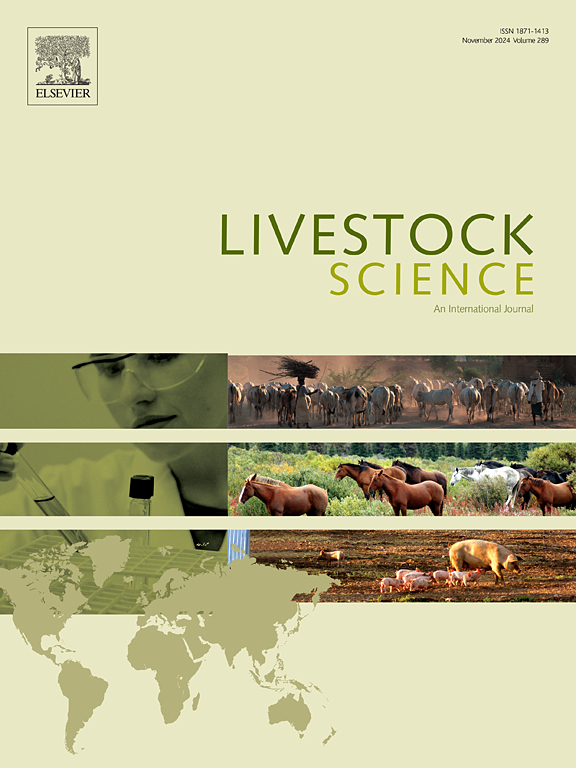添加乳化剂的低能量日粮对肉鸡生长性能、营养物质消化率和肠道形态的影响
IF 1.9
3区 农林科学
Q2 AGRICULTURE, DAIRY & ANIMAL SCIENCE
引用次数: 0
摘要
本研究旨在探讨在能量缺乏日粮中添加乳化剂对肉鸡生长性能、肠道形态和营养物质消化率的影响。总共 540 只一天龄的雄性肉鸡被随机分配到一个 3 × 3 因式排列的处理中,每组 4 个栏,每栏 15 只肉鸡,共饲养 6 周。9 个处理包括 3 种乳化剂添加量(0、250 和 500 mg kg-1)以及标准、中等和低能量浓度[在开产期(0 至 10 日龄)、生长期(10 至 24 日龄)和育成期(24 至 42 日龄),中等和低能量浓度的表观代谢能(AME)/kg 分别比标准能量需求低 45 和 90、60 和 105 以及 75 和 120 千卡]。记录初生期、生长期、育成期和总饲养期(第 0 至 42 天)的平均日增重(ADWG)和平均日采食量(ADFI),并计算饲料转化率(FCR)。测定了第 5 至 10 日龄和第 35 至 40 日龄试验日粮的 AME、粗蛋白(CP)消化率、脂质消化率和有机物(OM)消化率。与饲喂不含乳化剂的日粮相比,饲喂含乳化剂的中等能量或低能量日粮的肉鸡的ADWG和LBW均高于饲喂标准日粮的肉鸡,但FCR较低(P <0.05)。随着日粮中乳化剂添加量的增加,活体重增加,而ADFI和FCR分别呈线性和二次下降(P <0.05)。与饲喂其他日粮的肉鸡相比,饲喂含 500 毫克乳化剂/千克的中等能量日粮或含 250 毫克乳化剂/千克的低能量日粮的肉鸡绒毛高度更高(P < 0.05)。在日粮中添加乳化剂可使绒毛高度、上皮高度以及绒毛高度与隐窝深度比呈线性增长(P <0.05)。在中等能量和低能量日粮中,添加乳化剂可提高脂质和 OM 的 AME 和消化率(P < 0.05)。随着日粮中乳化剂添加量的增加,脂质和 OM 的 AME 和消化率分别呈线性和二次曲线增加(P <0.05)。总之,在初生、生长和育成期的中低能日粮中添加至少 250 毫克/千克的乳化剂,可以通过改善小肠组织学特性和提高脂质消化率来提高肉鸡的生产性能。本文章由计算机程序翻译,如有差异,请以英文原文为准。
Effects of low energy diets supplemented with emulsifier on growth performance, nutrient digestibility, and intestinal morphology of broiler chickens
This study was conducted to investigate the effects of adding an emulsifier to energy-deficient diets on growth performance, intestinal morphology, and nutrient digestibility in broiler chickens. A total of 540 one-day-old male broiler chickens were randomly assigned to a 3 × 3 factorial arrangement of treatments with 4 pens and 15 broiler chickens/pen for 6 wk. Nine treatments consisted of 3 inclusion rates of emulsifier (0, 250, and 500 mg kg-1) and the standard, moderate, and low energy concentrations [45 and 90, 60 and 105, and 75 and 120 kcal apparent metabolizable energy (AME)/kg less for the moderate- and low-energy concentrations than the standard energy requirements during the starter (d 0 to 10), grower (d 10 to 24), and finisher (d 24 to 42) phases, respectively]. The average daily weight gain (ADWG) and average daily feed intake (ADFI) were recorded in the starter, grower, finisher, and total rearing (d 0 to 42) phases and feed conversion ratio (FCR) was calculated. The AME, digestibility of crude protein (CP), lipid, and organic matter (OM) of experimental diets, were determined from d 5 to 10 and from d 35 to 40. Broiler chickens fed moderate- or low-energy diets containing emulsifier showed greater ADWG and LBW, than those fed the standard diets along with lower FCR, compared to the same diets without emulsifier (P < 0.05). Live body weight increased, while both ADFI and FCR decreased linearly and quadratically with an increase in emulsifier inclusion rate in the diets (P < 0.05). Broiler chickens fed moderate-energy diets with 500 mg emulsifier /kg or low-energy diets containing 250 mg emulsifier /kg had greater villus height compared to those fed other diets (P < 0.05). The addition of emulsifiers to diets led to a linear increase in villus height, epithelium height, and the villus height to crypt depth ratio (P < 0.05). In moderate- and low-energy diets, the inclusion of emulsifiers resulted in greater AME and digestibility of lipid and OM (P < 0.05). The AME and digestibility of lipid and OM increased linearly and quadratically with an increase in emulsifier inclusion rate in the diets (P < 0.05). In conclusion, the addition of emulsifier at a rate at least 250 mg kg-1 to moderate- or low-energy diets during the starter, growth, and finisher phases can enhance broiler chicken performance by improving the histological characteristics of small intestine and enhancing lipid digestibility.
求助全文
通过发布文献求助,成功后即可免费获取论文全文。
去求助
来源期刊

Livestock Science
农林科学-奶制品与动物科学
CiteScore
4.30
自引率
5.60%
发文量
237
审稿时长
3 months
期刊介绍:
Livestock Science promotes the sound development of the livestock sector by publishing original, peer-reviewed research and review articles covering all aspects of this broad field. The journal welcomes submissions on the avant-garde areas of animal genetics, breeding, growth, reproduction, nutrition, physiology, and behaviour in addition to genetic resources, welfare, ethics, health, management and production systems. The high-quality content of this journal reflects the truly international nature of this broad area of research.
 求助内容:
求助内容: 应助结果提醒方式:
应助结果提醒方式:


